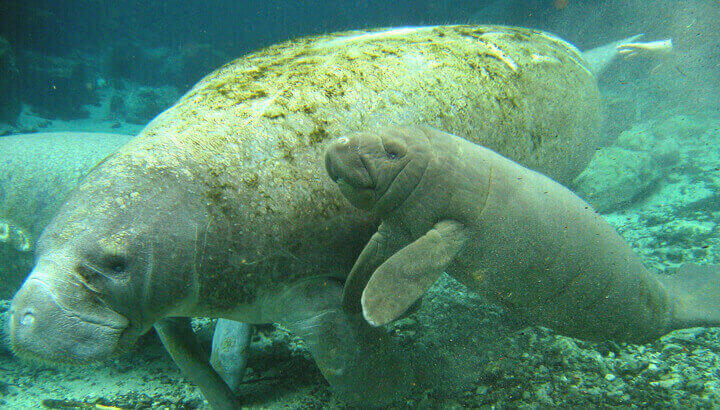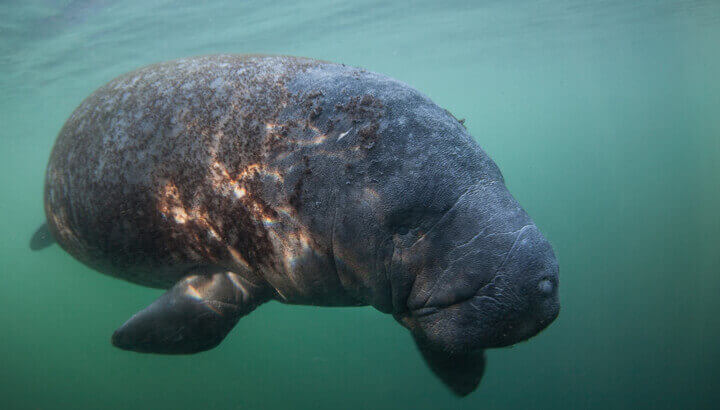
Manatee sex is now a known cause of traffic congestion in the Florida area, at least that is what Tampa residents found out recently. Traffic became backed up when several drivers left their vehicles on the Courtney Campbell causeway to watch a rare act by a group of manatees. The marine mammals are in the middle of mating season, which began in March and can run all the way to October.
The mating act that caused the lookie-loos to get out of their cars has been romantically referred to by experts as a “manatee mating ball.” At first glance, this mating ball appears to be a group of manatees all frolicking with each other in very shallow water. Next, the males practically drown each other to earn the chance to mate with a female. Usually there is just one female nearby while as many as 25 manatees duke it out over the right to mate with her.
Manatees only mate once every few years, so witnessing this act of several 1,000-pound manatees all flopping over each other is an incredibly rare site, one that evidently warrants blocking up traffic on a lowly Tuesday afternoon.
Manatees and mermaids
They say that it was scurvy-riddled sailors mistaking manatees for hybrid fish-women that originally led to the legend of mermaids. The most famous of such stories involved Christopher Columbus writing in his journal about his crewmembers seeing mermaids, which came up out of the water to greet them. Unlike how they are portrayed in popular culture, however, Columbus’ journal account of this meeting mentioned that the mermaids “had very masculine features.”
When Columbus returned to Europe, his crew’s stories of the mermaids grew in myth, and some manatees were even captured and killed in order to be put on display.
The upper body of manatees have many features that a scurvy-inflicted crew could see as human from a distance. They have finger-like bones on their upper limbs, and their necks and heads are able to turn in a similar fashion to ours. As a result, Columbus and his crew are not the only ones to have reported mermaid sightings whilst sailing through manatee habitat.
Ancient cave drawings in Malaysia portray the manatee’s cousin, the dugong, as a revered “lady of the sea.” Similar legends have also been discovered in Palau.
Manatee population

Manatee populations have successfully rebounded from 1991, when an estimate listed less than 1,300 in existence. Now estimates show that more than 6,000 manatees (also called “sea cows”) are currently living in Florida’s waters. (Populations of sailors with scurvy, however, have decreased drastically in recent years.)
Earlier this year, based on the recent population data, the U.S. Fish and Wildlife Service recommended that manatees be reclassified from “endangered” to “threatened.” Despite the population rebound, many conservationists are not too enthusiastic of changing the manatee’s status. The non-profit organization Save The Manatee issued a statement stating that the recommendation from the U.S. Fish and Wildlife service is based on flawed computer data and ignores the impact that increased waterfront development will have on manatee populations.
Many are also concerned that the reclassification of manatees could reduce efforts to conserve their population, such as the curbing of slow zones for boats that were created to reduce wildlife collisions with boat propeller blades.
Human impacts on manatee populations
Unfortunately for the manatee, they are often unable to get out of the way of propeller blades on boats, which can lead to mutilation or death. Even if the impact from the blades isn’t fatal to the manatee, the deep cuts can get infected and eventually become fatal. Manatees can be observed with as many as 50 deep cuts to their back, and are identifiable to researchers based on the visible damage they have endured.

Unfortunately, despite the best efforts of conservationists, this is a problem that is only getting worse. In fact, 2016 is on pace to be the worst year yet for manatees killed in boat collisions. In Florida, where almost half of the world’s manatee population resides, the Florida Fish and Wildlife Conservation Commission counted 71 manatee deaths due to boat collisions as of July of this year. In comparison, there were only 58 manatee deaths from boating collisions at the same time in 2015.
Considering the impact that human activity has had on manatee populations, not only should we be stopping traffic to watch their mating-rituals, we should be cheering them on!
— Ian Carey

